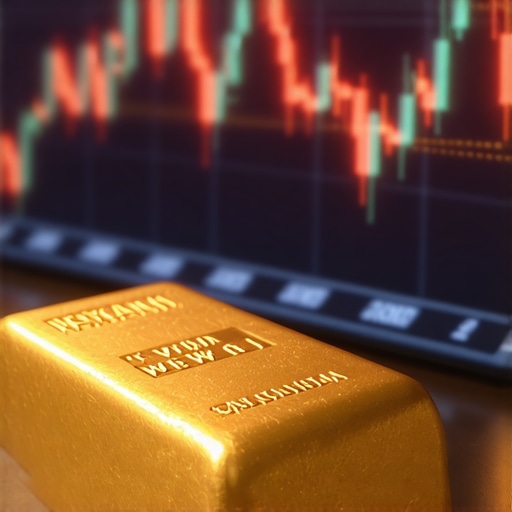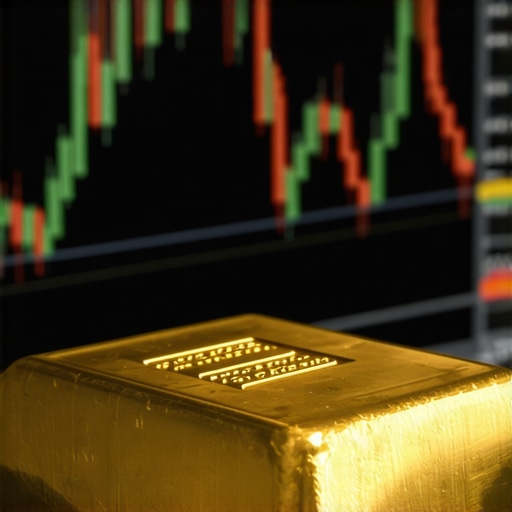Understanding Gold Prices: The 2025 Forecast
The world of gold investment is continually evolving, shaped by economic trends, geopolitical events, and market demand. As we look toward 2025, forecasting gold prices has become an essential exercise for investors keen on maximizing their returns. With the inherent volatility of gold prices, understanding what experts predict can provide valuable insights for making informed investment decisions.
Factors Influencing Gold Prices in 2025
Several key factors are anticipated to influence gold prices in 2025. Firstly, global economic conditions will play a significant role. Experts suggest that inflation rates and interest rates will be pivotal in determining gold’s appeal as a safe-haven asset. During periods of economic uncertainty, gold often sees increased demand, driving prices higher. For instance, as inflation rises, more investors may turn to gold as a hedge against declining purchasing power. This trend was evident in past economic downturns, and many analysts expect a similar pattern as we move toward 2025.
Another factor to consider is the role of central banks in the gold market. In recent years, there has been a noticeable increase in gold purchases by central banks globally. This trend indicates a growing recognition of gold’s value in diversifying reserves and protecting against economic instability. As central banks continue to accumulate gold, this could further support prices in the coming years. For a deeper understanding of how central banks influence gold prices, see our article on how central banks influence gold prices.
Market Demand Trends and Predictions
Market demand for gold is also expected to shift in 2025, driven by various sectors including jewelry, technology, and investment. The jewelry sector, particularly in emerging markets, remains a significant contributor to gold demand. As economies in these regions expand, the appetite for gold jewelry is likely to grow, supporting higher prices. Moreover, the increasing use of gold in technology, especially in electronics, may further bolster demand.
Investment demand is also a critical component. Gold Exchange-Traded Funds (ETFs) have gained popularity among investors looking for a more liquid way to invest in gold. As more investors seek to diversify their portfolios with gold, the overall demand is projected to rise. For beginners interested in gold ETFs, our guide on understanding gold ETFs provides essential insights.
Expert Predictions and Insights
Experts’ predictions regarding gold prices for 2025 vary. Some analysts anticipate a bullish outlook, citing factors such as increased global economic instability and ongoing inflationary pressures. Others, however, suggest that if economic recovery continues and interest rates rise, gold could face downward pressure. Staying informed about these expert analyses can aid investors in making strategic decisions. For a comprehensive overview of trends, check out our article on 2025 gold price forecasts.
As we navigate through 2025, understanding the multifaceted influences on gold prices will be crucial for investors. By keeping abreast of market trends and expert predictions, investors can position themselves strategically to take advantage of potential opportunities in the gold market.
Gold Investment Strategies: Adapting to Market Trends
As we delve deeper into the dynamics of gold prices in 2025, it’s essential for investors to consider various gold investment strategies that align with market trends. With the anticipated fluctuations in gold prices, developing a strategic approach can be the key to maximizing returns. One strategy involves diversifying your portfolio with different forms of gold investments, such as gold coins, bars, and ETFs. For insights on choosing the best investment types, refer to our guide on best gold investment types for 2025.
Understanding Economic Indicators
Economic indicators play a critical role in forecasting gold prices. Key metrics such as Gross Domestic Product (GDP), unemployment rates, and consumer confidence indices can significantly influence market sentiment. As these indicators fluctuate, they can affect investor behavior, resulting in either increased demand for gold or a shift toward alternative investments. For instance, a decline in GDP may lead investors to seek refuge in gold, reinforcing its status as a safe-haven asset. To stay ahead, it’s important to analyze gold demand trends regularly.
Geopolitical Events and Their Impact on Gold
Geopolitical tensions often have an immediate effect on gold prices. Events such as conflicts, trade wars, or political instability can lead to increased demand for gold, as investors flock to secure assets. The current global landscape suggests that geopolitical uncertainties will continue to persist, making gold an attractive option for those seeking stability. For a closer look at how these factors play into the broader market, consider our post on major influencers on gold prices.
Long-Term Perspectives: Gold as a Hedge Against Inflation
Gold’s reputation as a hedge against inflation continues to be a pivotal reason for its demand. As inflation rates rise, the purchasing power of currency diminishes, driving investors towards gold to preserve their wealth. Analysts anticipate that in 2025, inflationary pressures will remain a concern, reinforcing gold’s role as a protective asset. Understanding the benefits of gold as a hedge against inflation can provide investors with a strategic edge in their investment decisions.
Technological Innovations and Gold Demand
Another compelling factor influencing gold prices is the technological advancements that increase gold’s application across various industries. From electronics to medicine, the demand for gold in technology is expected to rise, further bolstering its market position. As investors, recognizing these trends can help in making informed decisions about when to buy or sell gold. You can learn more about the technological aspects in our exploration of different types of gold investments.
As we analyze these elements shaping the gold market, it becomes clear that informed investing requires a comprehensive understanding of both macroeconomic conditions and specific market dynamics. These insights not only prepare investors for potential challenges but also reveal opportunities that can arise in the ever-changing landscape of gold prices.
Evaluating Gold Investment Options in 2025
As the gold market continues to evolve, investors must evaluate various investment options to maximize their returns. The choice between physical gold, such as coins and bars, and paper assets like gold ETFs can significantly impact investment outcomes. Each option has its advantages and risks, making it essential for investors to align their strategies with their financial goals. For those new to gold investing, our guide for beginners provides crucial insights into different investment avenues.
Physical Gold: A Tangible Asset
Investing in physical gold remains a popular choice for many investors seeking security and stability. Gold coins and bars are tangible assets that can provide a sense of ownership and security, especially during times of economic uncertainty. However, it is vital to consider storage solutions and insurance for physical gold investments. For an in-depth look at effective storage options, check our article on storage solutions for physical gold.
Gold ETFs: Liquidity and Flexibility
Gold Exchange-Traded Funds (ETFs) have become increasingly popular due to their liquidity and ease of trading. These funds allow investors to gain exposure to gold prices without the need to physically own the metal. As more investors seek to incorporate gold into their portfolios, understanding how to navigate these investment vehicles can be beneficial. For a comprehensive overview of gold ETFs, refer to our article on how to invest in gold ETFs.
Gold Mining Stocks: Risk and Reward
Another avenue for gold investment involves gold mining stocks, which can offer significant upside potential but come with inherent risks. The performance of mining companies is often tied to both gold prices and operational efficiencies. Investors must conduct thorough research on mining stocks to evaluate their long-term viability and associated risks. To help you navigate this complex landscape, our post on evaluating gold mining stocks provides essential insights.
Risk Management Strategies in Gold Investing
With any investment, risk management is crucial. In the realm of gold investing, understanding market fluctuations and employing strategies to mitigate risks can help safeguard your investments. One effective method is diversifying your gold investments across various forms, such as physical gold, ETFs, and mining stocks. This strategy can reduce exposure to any single asset class and help stabilize overall investment performance.
Market Timing: Knowing When to Buy
Timing the market can be challenging, yet it plays a critical role in maximizing returns in gold investing. Monitoring economic indicators, geopolitical events, and market trends can provide valuable insights into optimal buying opportunities. For instance, if inflation rates are expected to rise, it may present a favorable time to invest in gold as a hedge against declining purchasing power. To stay informed, consider reading our article on what drives gold prices.
Long-Term Investment Mindset
While short-term trading can yield quick profits, a long-term investment strategy often results in more sustainable returns. By maintaining a focus on the fundamental value of gold and its role in economic stability, investors can make informed decisions that align with their financial objectives. Staying committed to a long-term perspective may also help investors weather market volatility. For further exploration of gold’s long-term value, check out our insights on gold as a long-term investment option.
Understanding the various strategies and options available for investing in gold is crucial for making informed decisions. As we delve deeper into the evolving landscape of gold investment, stay tuned for more insights into how to navigate this dynamic market effectively.
Understanding Gold Investment Options for 2025
Navigating the gold market requires a clear understanding of the various investment options available to investors. As we approach 2025, it’s essential to evaluate these opportunities critically, considering the evolving economic landscape and market conditions. Whether you’re a seasoned investor or just starting, understanding the nuances of gold investment can help you optimize your portfolio.
Physical Gold: The Security of Tangible Assets
Investing in physical gold, such as coins and bars, remains a favored choice for many due to its tangible nature. Owning physical gold provides a sense of security, particularly during periods of economic instability. However, it also necessitates considerations regarding storage and insurance to protect your investment. To dive deeper into effective storage solutions, check out our article on storage solutions for physical gold.
Gold ETFs: Flexibility for Modern Investors
Gold Exchange-Traded Funds (ETFs) offer a flexible and liquid way to invest in gold without physical ownership. They allow investors to buy and sell shares that track the price of gold, making it easier to gain exposure without the hassles of storage. As more investors turn to these instruments for diversification, it’s crucial to understand how to navigate them effectively. For a comprehensive overview, refer to our guide on how to invest in gold ETFs.
Gold Mining Stocks: Balancing Risk and Reward
Investing in gold mining stocks presents a unique opportunity to capitalize on the gold market while taking on additional risks associated with mining operations. The performance of these stocks is influenced by both gold prices and the operational efficiency of the mining companies. Conducting thorough research and analysis is vital to selecting the right mining stocks for your investment strategy. Our article on evaluating gold mining stocks provides essential insights to help guide your choices.
Strategic Considerations for Gold Investment
As you consider your options in gold investment, it’s important to adopt strategic approaches tailored to your financial goals. Balancing the different types of investments—physical gold, ETFs, and mining stocks—can help mitigate risks and maximize returns. Diversification remains a cornerstone strategy for effective investing.
Market Trends: Keeping an Eye on Economic Indicators
Staying informed about economic indicators and market trends is crucial for making educated investment decisions. Factors such as inflation rates, currency fluctuations, and geopolitical events can significantly impact gold prices. Regularly analyzing these trends can empower investors to time their investments wisely. For insights on analyzing market conditions, see our article on analyzing gold demand trends.
Long-Term Perspectives: Emphasizing Stability
While short-term trading can yield quick profits, a long-term investment strategy in gold often leads to sustainable growth. Recognizing gold’s historical role as a hedge against inflation, investors are encouraged to maintain a long-term perspective, focusing on its fundamental value. For a deeper understanding of gold’s long-term benefits, explore our insights on gold as a long-term investment option.
In conclusion, the gold market presents diverse investment opportunities that can align with your financial objectives. By understanding the various options, market trends, and strategic approaches, you can position yourself for success in 2025 and beyond.
Frequently Asked Questions about Gold Investment in 2025
What are the main factors affecting gold prices in 2025?
The main factors influencing gold prices in 2025 include economic conditions such as inflation and interest rates, demand from central banks, market demand from jewelry and technology sectors, and geopolitical events. Investors should stay informed about these elements to make strategic decisions.
How can I invest in gold in 2025?
Investors can choose from various options such as physical gold (coins and bars), gold Exchange-Traded Funds (ETFs), and gold mining stocks. Each option has its own benefits and risks, so it’s important to align your choice with your financial goals.
Is investing in gold a good hedge against inflation?
Yes, gold is traditionally viewed as a hedge against inflation. As inflation rises and the purchasing power of currency declines, many investors turn to gold to preserve their wealth, reinforcing its demand during inflationary periods.
What are gold mining stocks, and are they a good investment?
Gold mining stocks represent ownership in companies that extract gold. They can offer significant upside potential but also come with risks related to operational efficiency and fluctuating gold prices. Investors should conduct thorough research before investing.
What should I consider when buying physical gold?
When buying physical gold, consider factors such as storage solutions, insurance, and the premiums associated with purchasing coins or bars. It’s important to ensure your investment is secure and protected against theft or loss.
How do geopolitical events impact gold prices?
Geopolitical events, such as conflicts or political instability, often lead to increased demand for gold as a safe-haven asset. Investors typically flock to gold during uncertain times, driving prices higher.
What are the benefits of investing in gold ETFs?
Gold ETFs provide liquidity and flexibility, allowing investors to gain exposure to gold prices without needing to physically own the metal. They are easily tradable and can be a cost-effective way to diversify a portfolio.
How can I monitor gold market trends?
Investors can monitor gold market trends by keeping an eye on economic indicators such as inflation rates, consumer confidence, and currency fluctuations. Following financial news and reports from reputable sources can also provide insights into market conditions.
Are there risks associated with investing in gold?
Yes, like any investment, gold carries risks. Prices can be volatile, and factors such as interest rate changes and economic recovery can impact demand. Diversifying your investments can help mitigate some of these risks.
What is the outlook for gold investment in 2025?
The outlook for gold investment in 2025 is cautiously optimistic, with many experts predicting that demand will remain strong due to economic uncertainties and persistent inflationary pressures. However, investors should stay informed about market conditions to make educated decisions.
Authority Resources for Gold Investment Insights
For those seeking further information and expert insights on gold investment, consider exploring the following resources:
- World Gold Council – A leading authority on gold trends and investment insights.
- Investopedia – Offers comprehensive articles and guides on gold investing and market analysis.
- Kitco – Provides live gold prices, news, and expert commentary on the gold market.
- Bloomberg – Features financial news and analysis, including reports on gold and commodities.
- Forbes – Publishes articles and expert opinions on gold investment strategies.
By utilizing these resources, investors can enhance their understanding of the gold market and make informed decisions as they navigate the investment landscape in 2025. In conclusion, the journey of investing in gold is multifaceted and requires a keen awareness of market dynamics, economic indicators, and strategic approaches. By considering the various factors discussed and leveraging reliable resources, investors can position themselves for success in the evolving gold market.










The analysis of gold prices for 2025 is quite comprehensive here, especially with the emphasis on central banks’ increasing gold acquisitions. From my experience, central banks’ moves can signal broader market expectations that aren’t immediately obvious through typical economic indicators. Additionally, the discussion on gold ETFs versus physical gold investments highlights an important choice for both novice and seasoned investors. While physical gold provides tangible security, ETFs offer impressive liquidity and ease of trading, making them more attractive to those who prioritize flexibility. However, the risk management section is crucial; diversifying across physical gold, ETFs, and mining stocks can indeed help mitigate volatility risks associated with gold price fluctuations. I also appreciate the point made about geopolitical events and their immediate impact on gold demand — it’s something I’ve observed in the past where political instability in certain regions caused swift spikes in gold prices. Lastly, the long-term perspective on gold as an inflation hedge strongly resonates with me; maintaining patience through market ups and downs can lead to more sustainable returns. This kind of multi-faceted approach to gold investments is necessary given the complex factors influencing the market in 2025.
The detailed exploration of gold investment strategies for 2025 in this article really underscores the complexity of navigating the gold market. I’ve always found that understanding the macroeconomic indicators, such as inflation and interest rates, is indispensable when considering gold as a portfolio component. In particular, the piece’s emphasis on central banks’ increasing gold reserves aligns with trends I’ve seen driving scarcity and potentially elevating prices. Additionally, it’s interesting to consider the shift in demand from traditional sectors like jewelry to more tech-driven applications. This reflects a diversification in gold’s value proposition beyond mere ornamentation or safe haven status. From personal experience, investing in gold ETFs provides a convenient entry point, especially when physical storage concerns become a barrier, though I remain cautious about the lack of tangibility in such instruments. The article’s point about balancing physical gold, ETFs, and mining stocks for risk management is well taken — each has its own risk profile and benefits. Moreover, geopolitical tension as a catalyst for price shifts remains an unpredictable but significant factor. Altogether, this comprehensive perspective on gold price forecasting for 2025 helps solidify why gold continues to be a unique, multifaceted asset class worth careful consideration among investors.